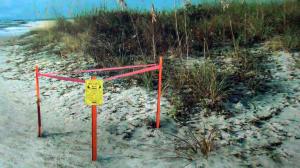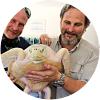 Travelers from around the world find many unique nature and wildlife viewing opportunities in Punta Gorda/Englewood Beach, and one of the most unique is the chance to encounter sea turtles. There are over 15,000 species of marine wildlife that call the gulf waters home, and this includes five of the world's seven-known sea turtle species.
Travelers from around the world find many unique nature and wildlife viewing opportunities in Punta Gorda/Englewood Beach, and one of the most unique is the chance to encounter sea turtles. There are over 15,000 species of marine wildlife that call the gulf waters home, and this includes five of the world's seven-known sea turtle species.
Timing is Everything
The general consensus is that Sea Turtle Nesting Season in southwest Florida runs March through October, though some organizations put the dates as late April/May through October.
This mean, of course, that those loggerheads, greens, Kemp's ridleys, leatherbacks, and hawksbill turtles are using the same Gulf beaches to nest and lay their eggs that we use for recreation and relaxation. Just a reminder that it's good to keep an eye out: your next summer beach trip could include an amazing experience few people get to witness.
If you're lucky enough to encounter a sea turtle, hatching, or even a nest, it's very important to appreciate the experience without disrupting the delicate life cycle of these elusive creatures.
Fascinating Sea Turtle Facts
- Between 60 and 180 eggs can be deposited in one nesting.

- A single turtle can repeat this process from 2 to 6 times in a single season, and always take 2 weeks between laying their clutches.
- Turtles return to the region of their own birth to nest, sometimes within a mile’s distance of where they hatched.
- A satellite-tracked leatherback completed a 12,774 mile trans-Pacific migration.
- Sand temperature determines the sex of the hatchlings. Generally, if the sand is warmer during the 2-month month incubation, the hatchlings will be female. If the sand is cooler, the hatchlings will be male.
- Hatchlings use the faint light of the horizon to find the water.
- 7 out of 10 hatchlings reach water. 1 in 1,000 survive to sexual maturity.
- The only sea turtle that nests during the day is the Kemp's ridley; most do their nesting at night.
As endangered or threatened, all sea turtles are protected under state and federal law from being possessed, disturbed or harassed. The same goes for their nests and eggs. Since most turtle nesting and hatching activities take place at night, ordinances prohibit artificial light from reaching the beach.
How to Avoid Injuring Turtles or Disrupting the Nesting or Hatching Process
-
Remove all items including furniture, towels, and toys from the beach at night. Clean up after yourself:
Clean up after yourself:
-
Smooth over the sand:
Fill in any holes you've made, and any you see. Hatchlings can easily get trapped in shallow holes in the sand.
-
Keep the dark, dark:
Avoid shining flashlights or light from vehicles or buildings onto the beach as this can frighten away nesting females and confuse hatchlings trying to get to the water.
-
Do Not Disturb:
View nesting or hatching turtles from a fair distance. If you're lucky enough to see a laying turtle or a hatchling begin its journey, enjoy the moment, but remain quiet and calm.
-
Never touch wildlife:
Don’t “help” a turtle or a hatchling get to where you think they’re going: always observe from at least 30 feet away.
Sea turtles are amazing and fragile animals that we share our beaches and marine environment with here in southwest Florida. It’s our hope that, like us, you may be fortunate enough to see one in the wild, and that we all continue working together to ensure their long-term survival.
Sea Turtle Nesting Season Quick FAQs
Back to Top of List
When is sea turtle nesting season in Florida?
Sea turtle nesting season in Florida is generally March 1 through October 31, with the most activity taking place May through July.
How can you tell a sea turtle nest from regular sand?
An un-marked nest is usually a mounded patch of sand that appears looser or softer than the sand around it. There may also be what look like tire tracks leading to and/or from the patch, and there will usually be no seaweed or other debris in the area.
Normally, a local turtle conservation group will already have marked the nest.
How many eggs do sea turtles lay?
Sea turtles typically lay between 2 and 6 clutches, two weeks apart, each nesting season. Each clutch will have anywhere from 65 eggs to 180.
How long do sea turtles live?
Generally, sea turtles can live 50 years or more, though it's difficult to pin down exact life expectancy. Reaching maturity can take 20 to 30 years, and most will actively reproduce for 10 more years.




